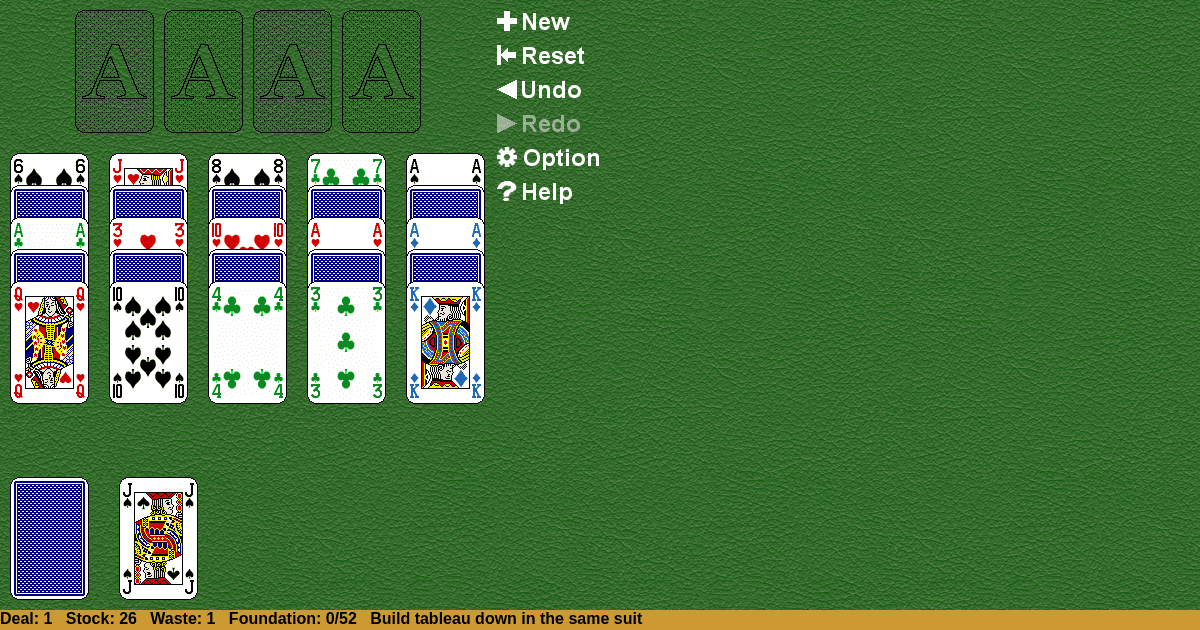Single Interchange
Home |
How to play |
FAQ |
About
How to play Single Interchange?
Single Interchange Solitaire: How to Play
Game Objective
The primary objective of Single Interchange Solitaire is to move all cards from the tableau to the eight foundations, building each foundation up by suit from Ace to King. A player wins when all 104 cards are successfully organized into the eight complete foundation piles.
Setup & Layout
Single Interchange Solitaire is played with two standard decks totaling 104 cards. The game setup consists of the following components:
Tableau: Five tableau piles are arranged in a row. Each pile contains five cards dealt in a specific pattern. The cards are splayed downward to display all cards in each pile.
Card Orientation: Within each tableau pile, the even-numbered cards (2nd, 4th) are dealt face down, while all other cards (1st, 3rd, and 5th) are dealt face up.
Foundations: Eight foundation piles are established, one for each suit across both decks. These piles begin empty and are located separately from the tableau.
Stock: The remaining cards after the tableau is dealt form the stock pile, which is placed face down and used to introduce new cards into play.
Waste Pile: One waste pile is maintained for cards drawn from the stock.
Single Interchange Solitaire Rules
Foundation Building: Each foundation is built up by suit from Ace to King. An Ace may move to an empty foundation to begin a new foundation pile. Subsequent cards of the same suit may only be placed on top of the previous card in ascending rank order. For example, the 4♠ may move onto the 3♠, and the 4♦ may move onto the 3♦.
Tableau Building: The tableau piles build down by the same suit. For example, the 8♠ may move onto the 9♠, and the 8♥ may move onto the 9♥. Starting with the 8♥, the following sequence can build on top: 7♥, 6♥, 5♥, 4♥.
Sequence Movement: Sequences of cards built down by the same suit can move together as a group from one tableau pile to another, provided the lowest card in the sequence matches the building rules of the destination pile.
Empty Tableau Spaces: A King may move to an empty tableau pile. No other cards may move to an empty tableau pile.
Stock and Waste: The stock deals one card face up to the waste pile when accessed. Only the top card of the waste pile is movable to either the tableau or foundations.
Gameplay
During each turn, a player may perform the following actions:
Move a face-up card or a valid sequence of cards from the tableau to a foundation pile, if the move follows foundation building rules.
Move a face-up card or a valid sequence of cards from the tableau to another tableau pile, if the move follows tableau building rules.
Move the top card from the waste pile to either a foundation or a tableau pile, if a legal move exists.
Draw a new card from the stock to the waste pile when no other moves are available or desired.
When a card is moved from a tableau pile, any face-down card that becomes exposed is automatically turned face up, making it available for play.
The game continues with players repeating these actions until either a winning condition is achieved or no further legal moves remain.
Winning & Losing Conditions
Winning Condition: A player wins when all 104 cards have been successfully moved to the eight foundations, with each foundation containing a complete sequence from Ace to King in the same suit.
Losing Condition: A player loses when no legal moves remain available and the stock pile has been exhausted. This occurs when cards remain in the tableau or waste pile that cannot be moved to either the foundations or other tableau piles according to the established rules.
Special Rules & Edge Cases
Face-Down Card Exposure: When a face-up card is removed from a tableau pile, any face-down card directly beneath it is immediately turned face up, making it eligible for play in subsequent turns.
Empty Tableau Restrictions: Only a King or a sequence beginning with a King may be placed in an empty tableau pile. This restriction limits the options for creating empty spaces and adds strategic depth to the game.
No Redeals: Single Interchange Solitaire does not permit redeals of the stock pile. Once all cards from the stock have been drawn to the waste pile, no additional passes through the deck are allowed. This restriction makes Single Interchange Solitaire significantly more challenging than variations that permit unlimited redeals.
Limited Strategic Options: Due to the small number of tableau piles (five) and the restricted movement options, Single Interchange Solitaire offers minimal strategic choices. Success depends heavily on favorable card distribution rather than player decision-making.




























































